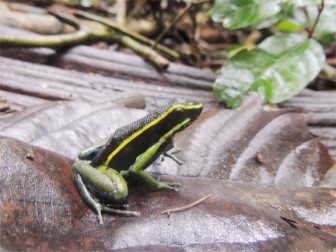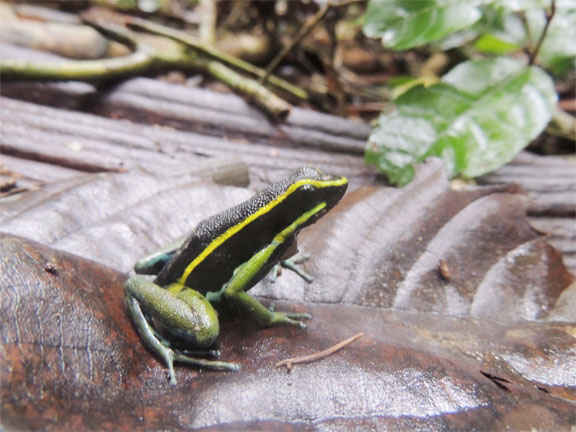Hiking through the forests of Guyana’s interior is an experience for the senses. Sounds of birds and monkeys echo from above, crickets call and cicadas hum. The gentle breeze in the canopy causes the ancient giant trees to arch and creek around you. Branches snap and leaves crackle as secretive creatures bound through the forest floor in every direction. The warm, thick air brings beads of sweat to your brow and the scent of the moist air is sweet with the smell of decomposing leaves. Through all of this, an electric flash of brilliant yellow near your feet draws your attention.
As you attempt to follow the path of movement with your eyes, it bolts again. When you are able to focus on it before it springs into action once again, you meet eyes with one of the most beautiful creatures in the forest – the three-striped poison dart frog (Ameerega trivittatus). You attempt to move in quietly for a closer look. But magically, the frog disappears beneath the leaf litter with the greatest of ease.
The three-striped poison dart frog is one of the largest and most widely distributed species of poison dart frog, as it can be found throughout northern South America. The individuals above were photographed near Maipaima Lodge near Nappi Village in Region 9. This beautiful frog derives the poison that it secretes from its skin by synthesizing chemicals in its food – termites, crickets, flies and ants. The second most toxic frog of its genus, contact with this frog can cause symptoms from severe cramping to local paralysis and seizures. Many indigenous peoples throughout the Amazon utilize the poison from this frog’s skin on the tips of their arrows to increase their hunting ability.
These frogs are unique in that they live in dense populations of individuals living in close proximity to one another and may mate at any time. Males of this species are rather thin while females can be much more robust (larger). To attract females, males take up positions near a puddle or a water-filled tree hollow and let out a beautiful peeping call that is repeated frequently to call in a female. If the female is sufficiently impressed by the call, she will lay eggs in this area, which the male fertilizes and then guards until their development is complete. Males will even carry their young on their backs when they move away from these laying ponds and will deposit them in another location. Male three-striped poison dart frogs are certainly dedicated fathers and their care is critical to the survival of the next generation of this unique and beautiful species.

Rain forests are rich in biodiversity and are home to many different plants and animals as well as indigenous communities.
Humans, even those who don’t live in the rain forest, rely on it for resources such as building materials (wood and lianas), medicine and fruits.
Rain forests also provide essential environmental services for life on earth; they create soil as well as prevent soil erosion, produce oxygen through photosynthesis, maintain clean water systems, and are a key defence against climate change.
The Iwokrama Rain Forest is 371,000 hectares, located in the heart of Guyana. Our mission is to develop strategies for conservation and sustainable development for local people in Guyana and the world at large.
We are involved in timber, tourism and training. Come and visit us in the rain forest or at http://www .iwokrama.org.

